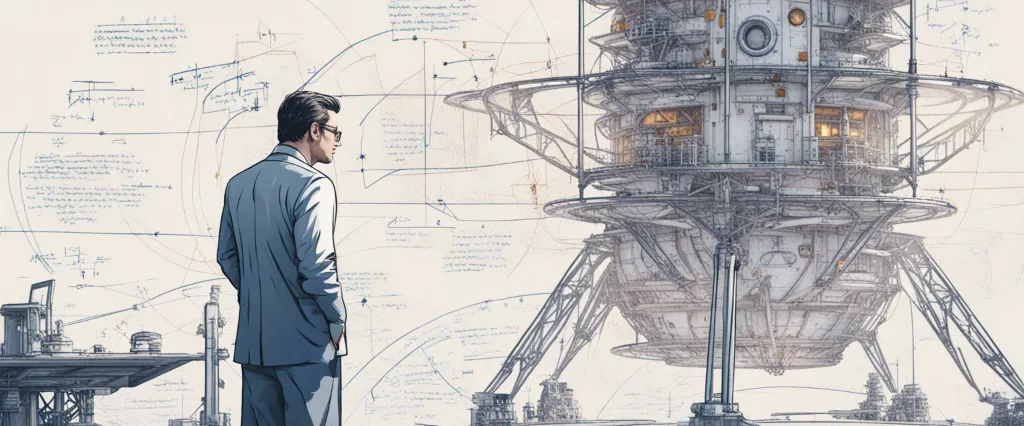In “Think Like a Rocket Scientist” by Ozan Varol, readers are invited on an enthralling journey through the mind of a rocket scientist, exploring the intellectual habits and problem-solving methods that can revolutionize any aspect of our lives. Varol, an acclaimed professor of Law and former NASA rocket scientist, combines his expertise in science and law to offer valuable insights on unleashing our inner creativity, breaking free from conventional thinking, and conquering complex challenges with ingenious strategies. In this captivating book, Varol shares his experiences alongside memorable anecdotes from the space industry, culling together a comprehensive guide for individuals seeking to think like a rocket scientist and achieve breakthrough results in their personal and professional lives.
Chapter 1: Thinking in Questions
Chapter 1 of “Think Like a Rocket Scientist” by Ozan Varol, titled “Thinking in Questions,” emphasizes the importance of adopting a questioning mindset to foster creativity and innovation. Varol, a former rocket scientist turned professor, highlights how questioning is a crucial skill used by scientists, engineers, and astronauts to solve complex problems and achieve remarkable breakthroughs.
The chapter begins by explaining that as we grow older, we tend to ask fewer questions and settle for simple answers. However, Varol argues that questioning is fundamental to human progress, whether individually or collectively. He underscores the significance of asking the right questions to steer our thinking in fruitful directions.
Varol introduces the concept of “first-principles thinking,” which involves breaking problems down to their fundamental truths and building solutions from the ground up. By questioning and challenging established assumptions, we can avoid the limitations of conventional thinking and unlock fresh insights.
The author also discusses how curiosity drives the questioning process, encouraging readers to cultivate a childlike sense of wonder. Varol suggests that embracing uncertainty and being comfortable with the unknown can lead to a more curious mindset that promotes creativity and original thinking.
Additionally, the chapter emphasizes the power of reframing problems through thoughtful questioning. Varol highlights that by changing our perspective, examining opposite viewpoints, and considering different angles, we can discover alternative solutions and possibilities that may have been hidden before.
In summary, Chapter 1 of “Think Like a Rocket Scientist” champions the value of questioning as a vital tool for innovation and problem-solving. By questioning assumptions, embracing curiosity, and reframing problems, individuals can expand their thinking and unlock new possibilities in their pursuit of success and breakthroughs.
Chapter 2: Reframing the Problem
In Chapter 2 of “Think Like a Rocket Scientist” by Ozan Varol, titled “Reframing the Problem,” the author emphasizes the importance of reframing problems in order to find unconventional solutions. Varol argues that thinking like a rocket scientist entails breaking free from conventional thinking patterns and seeing problems from different angles.
The chapter begins by highlighting how our brains are wired to seek familiar patterns and emphasize speed and efficiency over creativity. However, these ingrained thinking habits often lead us to overlook alternative solutions. Varol emphasizes that reframing problems is a critical step in unlocking innovative ideas.
The author introduces the concept of “second-level thinking,” which involves analyzing the assumptions and beliefs that underpin a problem and questioning their validity. By doing so, one can uncover new perspectives and approaches to addressing the problem.
Varol provides several techniques to help reframe problems effectively. One technique involves shifting the timescale, analyzing the problem in both short-term and long-term contexts. This approach enables a deeper understanding of the problem’s root causes and potential consequences, leading to more nuanced solutions.
The chapter also explores challenging our assumptions and biases by considering “out of the box” perspectives. Varol encourages readers to view problems through different lenses, such as those of a child, an alien, or an outsider, to gain fresh insights.
In summary, Chapter 2 emphasizes the need to break free from conventional thinking patterns, encouraging readers to reframe problems by questioning assumptions and biases. By exploring alternative perspectives and considering the timescale in which problems exist, individuals can develop innovative solutions that may go beyond their initial expectations.
Chapter 3: Thinking in Multiples
Chapter 3 of the book “Think Like a Rocket Scientist” by Ozan Varol, titled “Thinking in Multiples,” explores the concept of thinking in multiples and its significance in problem-solving and innovation. Varol emphasizes that pursuing a single solution is often limiting, and by thinking in multiples, we can broaden our perspectives and uncover novel alternatives.
The chapter begins by introducing the concept of Fermi questions, which involve making rough estimates through a series of informed guesses, allowing us to quickly assess the approximate scale or scope of a problem. These questions encourage a multiple thinking approach, forcing us to consider various potential solutions and not getting fixated on a single answer.
Varol then delves into the mental tool called the “premortem.” Unlike a postmortem, which analyzes failures after they occur, a premortem involves imagining potential future failures and issues before they happen. By envisioning possible problems, we can brainstorm multiple solutions and preemptively address any foreseeable obstacles, enhancing our chances of success.
Another strategy discussed in this chapter is the “interval training” technique. Just as athletes use interval training to improve their physical performance, Varol suggests applying the same approach to our thinking. Developing multiple ideas and iterating through different solutions boosts our mental agility, allowing us to explore various angles and potential outcomes.
Furthermore, the chapter highlights the value of adding new perspectives to our thought processes. By seeking out individuals with different backgrounds, experiences, and expertise, we can introduce diverse viewpoints, challenging our assumptions and uncovering innovative solutions that may not have been apparent through a single-minded approach.
In essence, Chapter 3 underscores the importance of thinking in multiples and diversified approaches to problem-solving. By embracing this mindset, we can foster creativity, enhance our problem-solving abilities, and unlock previously undiscovered possibilities.
Chapter 4: Thinking Counterfactually

Chapter 4 of “Think Like a Rocket Scientist” by Ozan Varol explores the concept of thinking counterfactually. This type of thinking involves considering alternatives and possibilities that did not occur in reality. By examining what could have been, we gain valuable insights and a fresh perspective on problem-solving.
The chapter begins by highlighting how humans are cognitive misers, often relying on mental shortcuts and default thinking patterns. However, thinking counterfactually requires training our minds to escape these default modes and consider unconventional possibilities. It involves asking “What if?” questions and challenging our assumptions.
Varol presents various techniques to develop counterfactual thinking. One approach is the “pre-mortem” technique, wherein you imagine that your plan has already failed and then identify the reasons behind this failure. This helps unveil potential weak points and enables proactive mitigation. Another method is the “9 Why’s” technique, where you repeatedly ask why until you reach the root cause of a problem, allowing you to address the underlying issues and create innovative solutions.
The chapter also emphasizes the importance of embracing failure. Varol highlights how failures are not dead ends but rather stepping stones to success. By reflecting on our failures, we can extract valuable lessons, refine our strategies, and ultimately increase our chances of success.
Thinking counterfactually also helps us understand the motivations and perspectives of others. By putting ourselves in someone else’s shoes, we develop empathy and gain new insights, leading to better collaboration and problem-solving in both personal and professional settings.
In summary, Chapter 4 of “Think Like a Rocket Scientist” introduces the concept of thinking counterfactually as a powerful tool for problem-solving. By challenging assumptions, contemplating alternative scenarios, and embracing failure, we can cultivate a mindset that leads to innovation and success.
Chapter 5: Making Bold Assumptions
Chapter 5 of “Think Like a Rocket Scientist” by Ozan Varol, titled “Making Bold Assumptions,” explores the importance of questioning deeply ingrained assumptions and thinking outside the box to achieve breakthrough results. Varol emphasizes that assumptions can act as mental barriers, limiting our potential and preventing us from transcending conventional wisdom.
The author highlights how assumptions shape our perception of reality and influence decision making. Varol asserts that the ability to challenge assumptions is a hallmark of rocket scientists, who constantly question and push boundaries. He introduces the concept of “parachuting in,” which involves entering a problem space with no preconceived notions, enabling fresh perspectives.
The chapter delves into the reasons why assumptions can be limiting and provides practical strategies to challenge them effectively. Varol stresses the importance of developing a curious mindset, embracing uncertainty, and asking the right questions. He illustrates this by recounting the story of Johannes Kepler and his bold assumption that planets move in elliptical orbits, defying the long-held belief in perfect circular motions. This assumption revolutionized our understanding of the universe.
Furthermore, Varol explores the concept of mental models, which are frameworks we develop to comprehend the world around us. While mental models are useful for navigating everyday life, they can also reinforce assumptions. The author encourages rocket scientists to expand their mental models and seek inspiration from diverse disciplines to break free from conventional wisdom.
In summary, Chapter 5 of “Think Like a Rocket Scientist” emphasizes the power of making bold assumptions by challenging ingrained beliefs and thinking outside traditional boundaries. By questioning assumptions, cultivating curiosity, and embracing uncertainty, individuals can unlock their creativity and uncover groundbreaking solutions to complex problems.
Chapter 6: Reverse Engineering
Chapter 6 of “Think Like a Rocket Scientist” by Ozan Varol delves into the concept of reverse engineering and its application in problem-solving and innovation. Varol emphasizes the importance of looking at problems from different angles and approaching them in unconventional ways.
Reverse engineering involves taking apart an existing design or solution and understanding its components and mechanisms to gain insights and inspiration for creating something new or solving a complex issue. Varol emphasizes that reverse engineering is not about copying; rather, it is a tool to understand the underlying principles and systems that make a solution work.
The chapter provides various examples of reverse engineering, such as how architects study ancient structures to learn about their construction techniques or how inventors analyze already existing technology to create breakthrough innovations. Varol also introduces the concept of “break-it-down Fridays,” which encourage tackling a problem by dissecting it into smaller, more manageable parts to comprehend its inner workings.
By reverse engineering, individuals can approach problems in a modular and systematic manner, leading to effective problem-solving. Varol encourages the reader to deconstruct complex issues into simpler components and understand how they interact. This approach allows for a deeper understanding of the problem and provides insights on how to improve or innovate upon existing solutions.
In conclusion, Chapter 6 of “Think Like a Rocket Scientist” highlights the power of reverse engineering as a mindset for problem-solving and innovation. By examining existing solutions or designs, one can gain valuable insights and leverage them to create something new or overcome complex challenges.
Chapter 7: Experimentation and Iteration
Chapter 7 of “Think Like a Rocket Scientist” by Ozan Varol explores the importance of experimentation and iteration in achieving success. Varol emphasizes that taking small steps, failing fast, and learning from those failures are vital in the process of innovation.
The chapter begins by discussing the story of Thomas Edison, who famously conducted thousands of experiments before successfully inventing the incandescent light bulb. Edison viewed each experiment as a step closer to success, even if it resulted in failure. Varol highlights the mindset of embracing failure as an opportunity for growth and learning.
Varol then introduces the concept of “small bets,” which involves taking calculated risks and making small investments in various ideas or projects. He argues that by experimenting with multiple options simultaneously, individuals or organizations increase their chances of stumbling upon breakthroughs. Failure of some ideas is acceptable, as long as valuable lessons are learned and applied to future iterations.
The chapter further emphasizes the importance of feedback loops in the iterative process. Varol encourages the creation of continuous feedback systems that gather data, evaluate results, and make adjustments accordingly. By collecting feedback from users, customers, or colleagues, one can iterate and improve upon their initial ideas and prototypes.
Varol also discusses how biases, both individual and organizational, can hinder experimentation and iteration. These biases, such as the fear of failure or the resistance to change, prevent individuals from taking risks and learning from failure. Overcoming these biases allows for a more open and adaptive mindset, ultimately fostering creativity and innovation.
In summary, Chapter 7 of “Think Like a Rocket Scientist” emphasizes the importance of experimentation, iteration, and embracing failure as part of the innovation process. Through small bets, continuous feedback loops, and overcoming biases, individuals and organizations can increase their chances of achieving groundbreaking success.

Chapter 8: Innovation and Creation
Chapter 8 of “Think Like a Rocket Scientist” by Ozan Varol focuses on the process of innovation and creation. The chapter delves into the mindset and strategies necessary for fostering breakthrough ideas and bringing them to life.
Varol begins by acknowledging the importance of embracing failure as a crucial component of the creative process. He emphasizes that failure is not the opposite of success but rather a stepping-stone to it. By reframing failure as feedback, rocket scientists are able to iterate and improve their ideas continuously.
The author then introduces the concept of “adjacent possible,” which refers to the space of new ideas that become possible when existing knowledge is expanded. Varol advises readers to actively seek out new knowledge and experiences in order to broaden their mental landscape and increase their chances of making breakthrough discoveries.
He further explores the process of ideation through a technique called “scamper,” which stands for Substitute, Combine, Adapt, Modify, Put to another use, Eliminate, and Reverse. This method provides a framework for thinking creatively and generating innovative ideas by challenging assumptions and exploring different perspectives.
Varol urges readers to be relentless questioners, encouraging them to constantly challenge existing assumptions and explore alternative ways of thinking. By embracing curiosity and cultivating a questioning mindset, individuals can uncover hidden possibilities and discover new solutions to complex problems.
Furthermore, the chapter emphasizes the value of collaboration and diversity in the creative process. Varol explains how bringing together individuals with diverse backgrounds and perspectives can lead to better problem-solving and idea generation. He highlights the importance of fostering an inclusive and respectful environment that encourages the sharing and cross-pollination of ideas.
In summary, Chapter 8 of “Think Like a Rocket Scientist” explores the process of innovation and creation. It emphasizes the importance of reframing failure, expanding existing knowledge, thinking creatively through the scamper technique, asking challenging questions, and fostering collaboration and diversity. By adopting these strategies and mindsets, readers can unlock their potential for generating breakthrough ideas and bringing them to life.
After Reading
In conclusion, “Think Like a Rocket Scientist” by Ozan Varol is a compelling guide that challenges readers to adopt a more creative and analytical mindset. Varol shares his experiences as a rocket scientist and provides practical strategies to help readers solve complex problems and achieve their goals. By emphasizing the importance of questioning assumptions, embracing failure, and thinking outside the box, Varol empowers individuals from all walks of life to expand their thinking and approach challenges with a new perspective. This book is essential reading for anyone seeking to ignite their own inner rocket scientist and unlock their full potential.
1. The Innovator’s DNA: Mastering the Five Skills of Disruptive Innovators” by Jeff Dyer, Hal Gregersen, and Clayton M. Christensen – This book explores the mindset and skills needed to think like an innovator, providing practical strategies to unleash your creative potential and approach problems with a fresh perspective.
2. The Power of Habit: Why We Do What We Do in Life and Business” by Charles Duhigg – Duhigg explores the science behind habits and how they can be harnessed to improve productivity and achieve success. This book will help you understand the power of routines and how to break free from unproductive patterns of thinking.
3. Sapiens: A Brief History of Humankind” by Yuval Noah Harari – This thought-provoking book provides a broad perspective on human history and addresses the question of what makes Homo sapiens the dominant species on Earth. It challenges conventional wisdom and encourages readers to think critically about our place in the world.
4. Thinking, Fast and Slow” by Daniel Kahneman – Nobel laureate Daniel Kahneman presents the concept of two systems of thinking: the fast, intuitive, and instinctive system, and the slow, deliberate, and rational system. This book dives into the cognitive biases that affect our decision-making and provides valuable insights into how to enhance our thinking processes.
5. Originals: How Non-Conformists Move the World” by Adam Grant – In this inspiring book, Grant shares the stories of original thinkers who have challenged the status quo and made significant changes in their fields. By exploring the characteristics of successful innovators, it encourages readers to break free from conventional thinking and pursue their own unique ideas.




